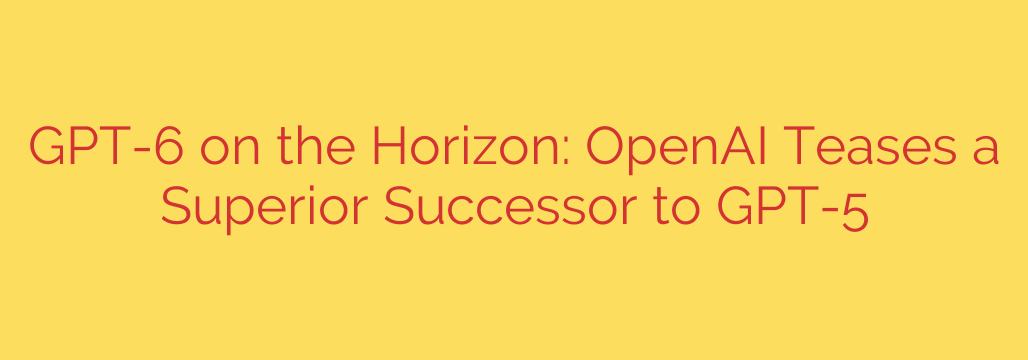
Beyond GPT-5: Is OpenAI Paving the Way for a GPT-6 Revolution?
Just as the world adapts to the ever-advancing capabilities of models like GPT-4o, the relentless pace of innovation in artificial intelligence pushes us to look further into the future. While discussions about GPT-5 are still swirling, whispers from within the AI community suggest that the groundwork is already being laid for its successor: a model that could be known as GPT-6.
This next-generation AI is not just an incremental update; it’s being envisioned as a monumental leap forward, potentially redefining the boundaries of what machine intelligence can achieve. As we stand on the cusp of this new era, it’s crucial to understand the potential advancements and their profound implications.
What Could Set GPT-6 Apart?
While concrete details remain under wraps, the development trajectory of large language models (LLMs) points toward several key areas of improvement. GPT-6 is expected to address the core limitations of current systems and introduce capabilities that sound like science fiction today.
Unprecedented Reasoning and Logic: Current AI can expertly mimic patterns in data, but it often struggles with multi-step reasoning and abstract problem-solving. GPT-6 aims to change that. The goal is a move from sophisticated pattern matching to genuine problem-solving intelligence, allowing the model to tackle complex scientific, mathematical, and philosophical questions with greater accuracy and depth.
True Multimodality and Environmental Understanding: We are already seeing models process text, images, and audio. The next frontier is seamless, real-time integration of video and other complex data streams. Imagine an AI that can not only watch a video but understand the physics, social dynamics, and unspoken context within it. This represents a shift toward AI with a more holistic and human-like perception of the world.
Drastically Reduced Hallucinations: One of the most significant challenges for current AI is its tendency to “hallucinate” or confidently state incorrect information. A primary focus for future models is achieving near-perfect reliability. For GPT-6, developers are targeting a state of near-perfect factual accuracy and logical consistency, making it a far more dependable tool for critical applications in medicine, law, and research.
Enhanced Agency and Proactive Assistance: Future AI will likely transition from being a reactive tool to a proactive partner. Instead of waiting for a prompt, GPT-6 could be capable of anticipating needs, managing complex long-term projects, and operating with a greater degree of autonomy to achieve user-defined goals. This evolution points toward the development of truly personalized and proactive AI assistants that can manage and execute complex tasks.
The Monumental Challenges Ahead
Creating a model as powerful as the rumored GPT-6 is not without significant hurdles. The resources required are staggering, and the ethical considerations are more pressing than ever.
First, the computational power and data needed to train such a model are immense, likely requiring next-generation hardware and an unprecedented amount of high-quality training information. This raises concerns about energy consumption and the environmental impact of AI development.
Second, and most importantly, is the issue of safety and alignment. As an AI’s intelligence and autonomy increase, ensuring that its goals remain aligned with human values is paramount. Robust safety protocols and ethical guardrails are not optional—they are essential to prevent unintended consequences from a system with such advanced capabilities.
How to Prepare for the Next Wave of AI
While the arrival of GPT-6 is still on the horizon, its development signals a clear direction for the future of technology. Individuals and businesses can take steps now to prepare for this transformative shift.
Cultivate AI Literacy: Don’t wait for the technology to arrive. Start learning about how current AI models work, understanding their strengths and weaknesses. Developing critical thinking skills to evaluate AI-generated content is more important than ever.
Focus on Human-Centric Skills: As AI handles more technical and data-driven tasks, skills like creativity, emotional intelligence, complex strategy, and ethical leadership will become even more valuable. Focus on abilities that complement, rather than compete with, machine intelligence.
Prioritize Digital Security and Verification: More powerful AI means more sophisticated potential for misuse. Always cross-reference and verify critical information provided by any AI model. Be vigilant about the potential for advanced phishing scams, misinformation campaigns, and deepfakes that will become easier to create.
The road to GPT-6 is long, but the journey has already begun. The evolution from our current AI tools to the next generation will be transformative, promising to unlock new possibilities for innovation and progress. The question is no longer if a model with these capabilities will arrive, but how we will choose to integrate its power into our world responsibly.
Source: https://www.bleepingcomputer.com/news/artificial-intelligence/openai-says-gpt-6-is-coming-and-itll-be-better-than-gpt-5-obviously/








